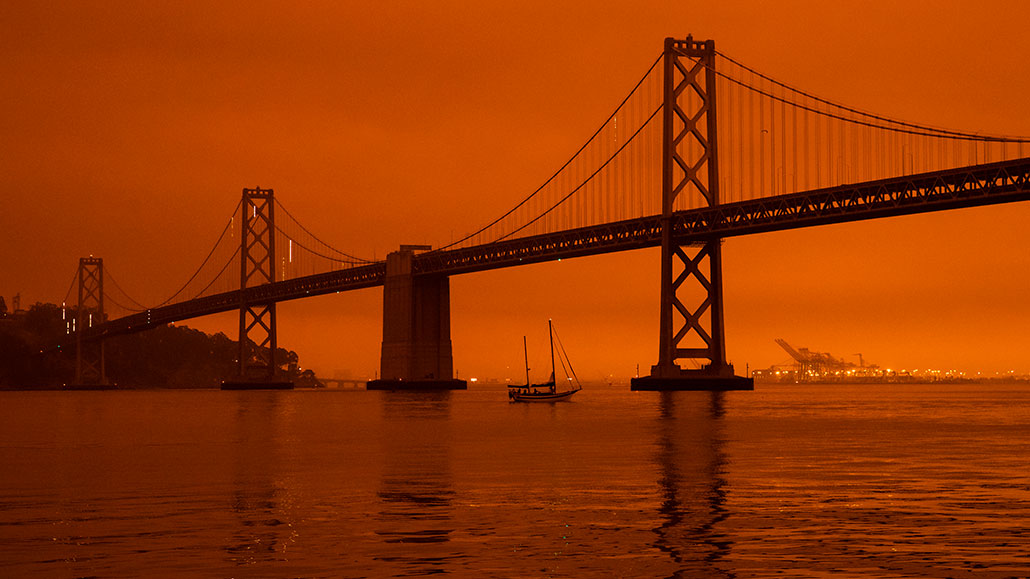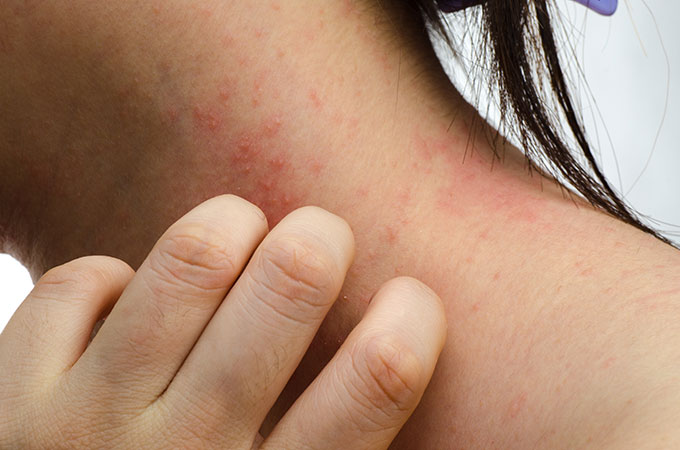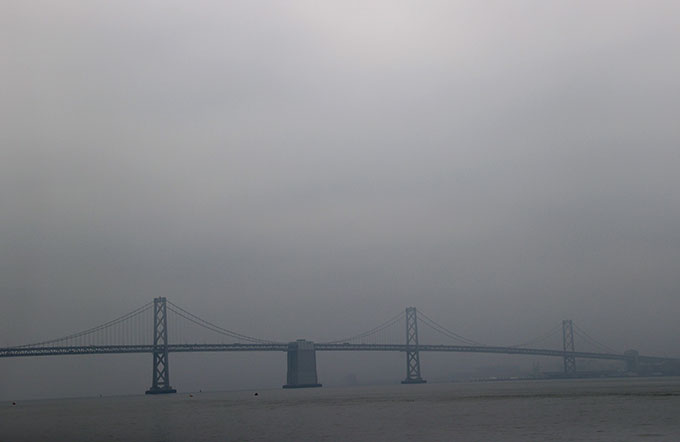Warning: Wildfires might make you itch
Add eczema and itch to the list of health hazards from wildfire smoke

Smoke from wildfires mixed with sunlight last September to give a burnt orange glow to the morning and evening skies around San Francisco, Calif. The aerosols spewed by those fires can make people itch, new data show.
Philip Pacheco/Stringer/Getty Images News
A burnt orange sky greeted San Francisco’s early risers for several days in November 2018. The California city’s residents usually enjoy good air quality. For nearly two weeks in a row, however, the air quality ranged from unhealthy to very unhealthy. The cause: a raging wildfire some 280 kilometers (175 miles) away. A new report now links pollution from that Camp Fire to flareups of eczema. This itchy skin condition affects almost one-in-three Americans, mostly children and adolescents.
More worrisome, polluting wildfires are likely to become even more of a problem in the future as Earth’s climate continues to warm.
The Camp Fire was California’s deadliest and most destructive. It started on November 8, 2018 and lasted 17 days. Before it was over, it destroyed more than 18,804 buildings or other structures. It also left at least 85 people dead.
But the inferno’s health effects ranged far beyond the 620 square kilometers (153,336 acres or about 240 square miles) that burned. The fire emitted high levels of aerosols that polluted the air. These far-flung particles are so small they can be breathed deeply into the lungs. A large share of these aerosols were just 2.5 micrometers in diameter or smaller. Such tiny bits can inflame airways, harm the heart, alter brain functions and more.
Even from miles away, smoke from wildfires can make people feel awful.
Some people will be coughing, says Kenneth Kizer. He’s a medical doctor and public health expert with Atlas Research. It’s based in Washington, D.C. What’s more, he notes, “The eyes burn. The nose runs.” Even your chest may hurt as you breathe irritants into your lungs.
A former firefighter, Kizer chaired a committee that considered what California’s wildfires might mean for health, communities and planning. The National Academies of Science and Medicine published that program’s report last year.
But it wasn’t quite complete. This past April 21, researchers also linked pollution from the Camp Fire to eczema and itchy skin.

Educators and Parents, Sign Up for The Cheat Sheet
Weekly updates to help you use Science News Explores in the learning environment
Thank you for signing up!
There was a problem signing you up.
Irritated and inflamed
The new study looked at cases of such skin disease not only during and after the Camp Fire, but also before it. Normal skin acts as a good barrier to the environment. That’s not true in people with eczema, explains Maria Wei. Their skin can be sensitive from head to toe. Blotchy, bumpy or scaly rashes may break out.
Wei is a dermatologist at the University of California, San Francisco (UCSF). Eczema’s “itch can be very life-altering,” Wei says. It affects people’s moods. It may even cause people to lose sleep, she notes.
Wei and others looked at visits to UCSF dermatology clinics over an 18-week period, starting in October 2018. The team also reviewed data for the same 18 weeks starting in October 2015 and October 2016. There were no large wildfires in the area at those times. In all, the team reviewed 8,049 clinic visits by 4,147 patients. The researchers examined data for fire-related air pollution during the study period, too. They also looked at other factors that can affect skin sensitivity, such as temperature and humidity.

The surprise finding, Wei reports: “A very short-term exposure to air pollution causes an immediate signal in terms of skin response.” For instance, clinic visits for eczema went up in all age groups. This started the second week of the Camp Fire. It kept up for the next four weeks (except for the week of Thanksgiving). That’s in comparison to clinic visits before the fire and after December 19.
Children’s visits climbed by nearly 50 percent compared to the period before the fire. For adults, the rate rose by 15 percent. That trend wasn’t surprising. “When you’re born your skin isn’t totally mature,” Wei explains. So eczema generally is more common in children than adults.
The team also saw a link — or correlation — between fire-related pollution and oral eczema medicines prescribed to adults. Those medicines often are used for severe cases where skin creams don’t provide relief.
Smoke-related aerosols might affect the skin in different ways, Wei says. Some chemicals are directly toxic to cells. They may cause a type of cell damage known as oxidation. Others may set off an allergic reaction. Even stress about the wildfire can play a role, she adds.
Her team described its findings in JAMA Dermatology.
The study looked only for links to one wildfire. Its findings may not apply to other wildfires and other places, the team warns. Their study also looked only at data from one hospital system.
To Kizer’s knowledge, this paper is the first to link eczema and itch to pollution from a wildfire. He did not work on the study. But he did write a commentary about it in the same April 21 JAMA Dermatology.

Wildfires on the rise
Spring in California is very dry this year. So experts expect the summer and fall of 2021 to see a severe wildfire season. “And the wildfires are just going to layer on and add to the health burden of whatever air pollution is there already,” Kizer says.
Since 2000, California’s wildfire season has gotten longer. It peaks earlier, too. Those findings come from graduate student Shu Li and environmental engineer Tirtha Banerjee. They’re at the University of California, Irvine. They shared their work in Scientific Reports on April 22.
More work is needed before the findings by Wei’s team can be applied generally, Li says. “Particles from extreme wildfires can be carried over great distances.” However, she adds, “their concentration can also be diluted.” She would like to know how high the wildfire pollution has to be to trigger skin effects.
Large wildfires due to lightning and other natural causes are the main reason why more area is getting burned, Li and Banerjee found. But it’s the frequency of small human-caused wildfires that has gone up most rapidly. These smaller blazes burn through fewer than 200 hectares (500 acres).
“Which [size fire] has a greater impact on human health?” Li asks. Right now, no one knows.
And California isn’t the only place that should worry. More urban areas across the western United States have had poorer air quality during the summer than in the past. Wildfires explain why, say researchers in Utah, Colorado and Nevada. They reported their findings April 30 in Environmental Research Letters.
What to do
Medicines can treat eczema and itch, Wei says. See a doctor if you want relief, she advises. That’s true whether it’s wildfire season or not.
Better still, take precautions, she says. If wildfire smoke pollutes your air, stay indoors. If you must go out, wear long sleeves and long pants. Moisturize your skin, too. That can provide an extra barrier to pollution.
Better planning can help communities prevent some wildfires, Kizer says. Longer term, people can cut down on greenhouse-gas emissions. Those reductions can rein in the impacts of climate change. However, some climate-change impacts are here to stay. “This is part of the picture that the young people are going to have to live with,” Kizer says. “And it’s not a pleasant part of the future.”







